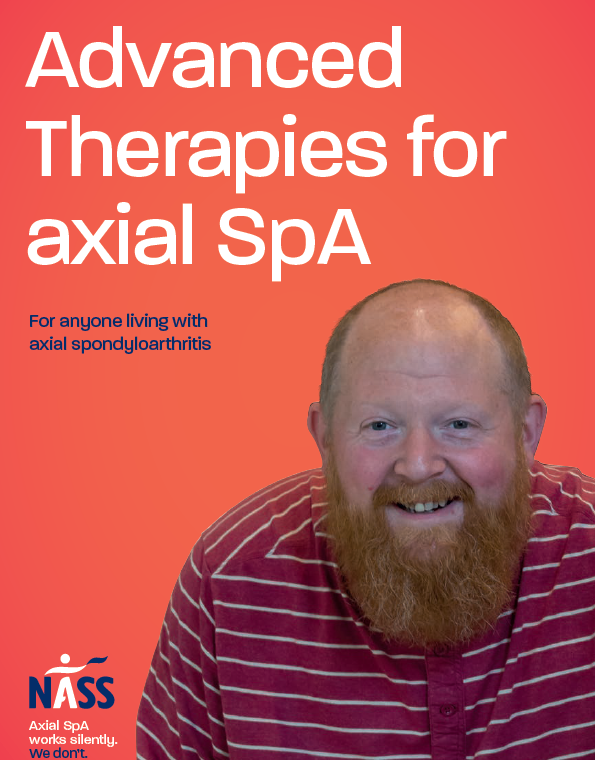
Keeping active
Find out more about the benefits of activity
Read moreDiscover the role of biologic therapy in managing axial SpA (AS)
This information is for anyone with axial spondyloarthritis (axial SpA), including people with ankylosing spondylitis (AS)
Unlike medications like paracetamol or ibuprofen, which are small chemical agents, biologic medicines are complex proteins. They target specific molecules believed to be involved in axial SpA. They are made up of genetically engineered proteins and are very large, complex molecules.
The most common forms are called monoclonal antibodies. This gives many of these drug names their ‘mab’ ending.
Most biologics are designed to block specific aspects of the immune system and can be thought of as ‘targeted therapies’. They work by blocking aspects of the immune system to slow down the attack on your joints and spine.
Because these therapies are proteins, they do not work as tablets and have to be given as injections into the skin.
Not everyone with axial SpA will need to take biologic therapy. Some people are able to manage their condition well with a combination of physiotherapy and non-steroidal anti-inflammatory drugs (NSAIDs) such as ibuprofen or naproxen.
However, some people still have active or progressive symptoms despite these treatments and they may require biologic therapies.
Your rheumatology consultant or nurse might talk to you about biologic therapy if:
Biologic therapy can only be prescribed by a consultant rheumatologist. Your GP cannot offer it to you. If you are not under the care of a rheumatologist do ask your GP to refer you.
The National Institute for Health and Care Excellence (NICE) has produced written national guidelines about prescribing anti TNF therapy and anti IL-17A that must be followed. Your rheumatologist will advise you if you meet the criteria for biologic therapy and they are safe for you.
There are a range of biologics licensed for axial SpA and approved by NICE. They all work by reducing the abnormal inflammation produced by the body.
There are more drugs currently in development and going through clinical trials which target these and other pathways, which should become available in the future if they are shown to work safely.
Anti-TNF therapy is used to treat a range of inflammatory conditions including non radiographic axial SpA (no changes on x-ray) and ankylosing spondylitis (changes on x-ray), as well as other conditions such as inflammatory bowel disease, rheumatoid arthritis and psoriasis.
These treatments interfere with the action of a protein called tumour necrosis factor (TNF) which is over-active in people with inflammatory arthritis, including axial SpA. Too much TNF can cause inflammation and damage to bones, cartilage and tissue. Anti-TNF therapy blocks the action of TNF and can reduce the amount of inflammation present in your body and joints.
There are a range of anti TNF options. The list below has the generic name and then the brand name afterwards in brackets. Where more than one brand name is listed this means the oroginal medication has lost its exclusivity or patent and, what are known as, biosimiliars have been produced.
Biosimilar medicines are developed to be highly similar to a biologic medicine. They can be developed by manufacturers once the original patent for the product has expired. They are called ‘biosimilar’ because the molecular structures are so complex that it is not possible to produce an absolutely identical drug to the original.
Adalimumab (Amgevita, Hulio, Humira, Hyrimoz and Imraldi)
Certolizumab pegol (Cimzia)
Etanercept (Enbrel, Benepali and Erelzi)
Golimumab (Simponi)
Infliximab (Remicade, Remsima, Flixabi and Inflectra)
Anti IL-17A therapy is approved by NICE to treat a non-radiographic axial SpA (no changes on x-ray) and ankylosing spondylitis (changes on x-ray). It works by neutralising the activity of a protein in the body called IL-17A.
IL-17A is a key protein in the skin inflammation in psoriasis. Research has shown that people with axial SpA have very high levels of IL-17A in their body and that it plays a very important role in causing the inflammation associated with axial SpA. By decreasing the IL-17A, this biologic reduces inflammation in your body and joints.
There are two anti IL-17A medications currently available:
Secukinumab (Cosentyx)
Ixekizumab (Taltz)
Bimekizumab (Bimzelx) is a humanized monoclonal IgG1 antibody that selectively inhibits IL-17F and IL-17A. This means that it’s working on a different area of the immune system than other biologics.
NICE have recommended bimekizumab as:
It is recommended only if anti TNF therapy is not suitable or does not control the condition well enough.
Biologic therapy works to reduce inflammation in your body and that means you should get less pain, less stiffness and more movement. Hopefully this will mean you can get moving more quickly in the morning, find it easier to carry out your daily activities, be able to exercise more and sleep better. In short, biologic therapy should give you a better quality of life.
It is thought that approximately 8 people out of every 10 will have a meaningful response to biologic therapy. It cannot reverse any damage or fusion of the spine and sacroiliac joints that has already occurred, but research has shown than many people with long-standing disease can still have significant improvement with biologic therapies. There is some evidence that biologic therapies may prevent new bone formation in the long-term. We hope to see more evidence for this over the coming years.
People who do not respond sufficiently (it may take 3-6 months to be certain), or who get serious side effects, will usually be recommended to stop their biologic therapy. If it is safe and appropriate to do so, your rheumatologist may suggest trying an alternative biologic therapy.
People generally tolerate these treatments well, but occasionally have to stop them due to side effects. Your rheumatologist should explain these possible side effects.
 Read our guide
Read our guideOur Guide to Advanced Therapies is informed by the 2025 British Society for Rheumatology (BSR) guideline for the treatment of axial spondyloarthritis with biologic and targeted synthetic DMARDs.
It includes information on the full range of currently available biologic medications as well as information on JAK inhibitors.

Find out more about the benefits of activity
Read more
Access affordable group physiotherapy
Read more
Download our guide to advanced therapies
Download